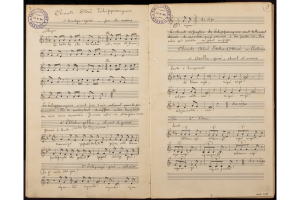In this week’s discussion, we talked about Frances Densmore and her work on native American music. Like a lot of the scholars we talked about in class, she is an interesting and conflicting character. For today’s post, I want to talk about something I found that is sort of similar to Densmore’s work. At the same time, we can have a conversation about authenticity and who defines it, how to define it (if that is even possible), as well as if it actually exists.
This source is an interesting transcription of some indigenous songs sung by people from various tribes from northwest Canada. This source dated back to 1862 to 1882, which is when Father Emile Petitot spent time in Mackenzie, British Columbia as a missionary priest to the indigenous people on the land. He collected, notated and transcribed their dances, games and ceremonies and put them together, which is the source I am introducing now. He also notated this in French. It is hard to determine who benefits from this source, but it is definitely safe to say that the indigenous people did not get enough credit for this. Emile Petitot is a guy with a ton of middle names (his full name is Emile-Fortune-Stanislas-Joseph Petitot) AND an Inuk name that translates to “Mr. Petitot, son of the sun.” He was a linguist and ethnologist, but I am not sure how credible he is at music notations. Given the fact that he was a priest, it would be reasonable to assume that he has at least some basic knowledge of music to support this transcription. However, it is always good to be a bit skeptical.
which is when Father Emile Petitot spent time in Mackenzie, British Columbia as a missionary priest to the indigenous people on the land. He collected, notated and transcribed their dances, games and ceremonies and put them together, which is the source I am introducing now. He also notated this in French. It is hard to determine who benefits from this source, but it is definitely safe to say that the indigenous people did not get enough credit for this. Emile Petitot is a guy with a ton of middle names (his full name is Emile-Fortune-Stanislas-Joseph Petitot) AND an Inuk name that translates to “Mr. Petitot, son of the sun.” He was a linguist and ethnologist, but I am not sure how credible he is at music notations. Given the fact that he was a priest, it would be reasonable to assume that he has at least some basic knowledge of music to support this transcription. However, it is always good to be a bit skeptical.
The source itself is like a lens that looks into the issue of transcribing music from a different culture, because it just seemed quite lacking. There was not really any background information about the music that was notated, other than titles, and on top of that his handwriting is very hard to read sometimes… The music notation seems to be very straight and there were only quarter notes and eighth notes, which could be how the music was, but once again, I am skeptical because of how much was neglected. Some of the pieces have key signatures and most of the pieces have time signatures, which to me is quite odd as well. I think this way of notation is basically putting a musical practice that does not stem from the Western Classical environment: it obviously would not go well.
This leads me back to Frances Densmore, who I personally think is doing at least something right. I am not saying that she is the end-all-be-all scholar for native American music; I would never put that title on someone who isn’t from the culture. However, I definitely would argue that recording the songs works so much better than notations, since you can physically hear the indigenous people singing the songs. People might also argue that it might not be as authentic if the musicians were being recorded; my thought is that yes, that might not be ideal, but there’s so many factors, some we can’t even control. Maybe there is no real authenticity.
Works Cited
Petitot, Father, Emile. 1862-1889. Chants indiens du Canada Nord-Ouest [manuscript]: recueillis, classés et notés par Émile Petitot, prêtre missionnaire au Mackenzie, de 1862-1882, 1889. [Manuscript]. At: Place: The Newberry Library. VAULT box Ayer MS 715. Available through: Adam Matthew, Marlborough, American Indian Histories and Cultures, http://www.aihc.amdigital.co.uk/Documents/Details/Ayer_MS_715 [Accessed November 03, 2021].
Savoie, Donat. “Emile Petitot (1838-1916).” Arctic, vol. 35, no. 3, Arctic Institute of North America, 1982, pp. 446–47, http://www.jstor.org/stable/40509367.
